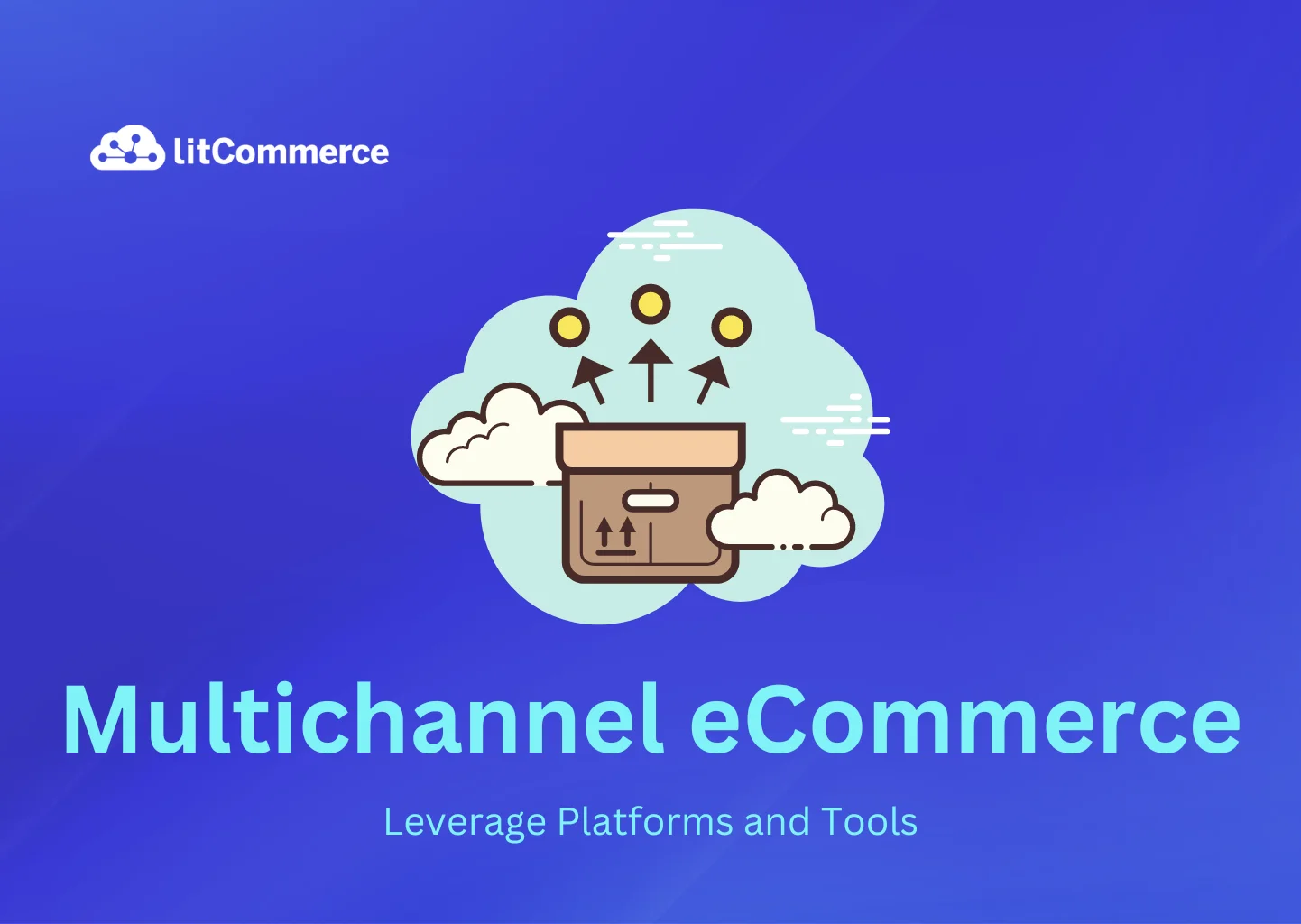Entering the multichannel eCommerce model may seem daunting, but it is one of the best things to happen to your business. From well-known platforms such as Amazon and eBay to social networks like Instagram and TikTok, multichannel eCommerce has no limits regarding customer outreach.
Sounds exciting, right? But with these opportunities come challenges, from managing multiple platforms to optimizing product listings. This article will introduce you to multichannel eCommerce, its advantages and disadvantages, and tips on defining suitable channels for the company.
What is Multichannel eCommerce?
Multichannel eCommerce is simply about selling your products or services across various online platforms. These platforms include a marketplace like Amazon or eBay, social media handles like Facebook or Instagram, and your own online store (website).
Multichannel eCommerce aims to:
- Market products to a massive audience
- Enable customers to place their orders using more than one method.
You might consider this successful guide to multichannel selling to skyrocket your sales and increase your brand exposure.
Take Bride Babes, for example, a store specializing in wedding attire and accessories.
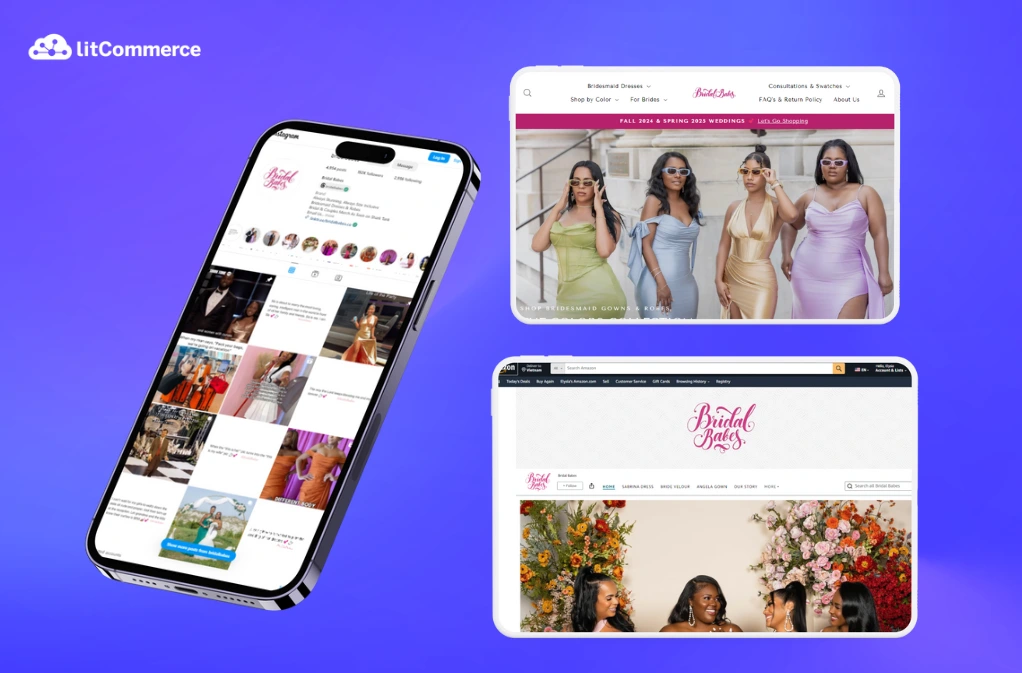
Although they also operate their own website, which acts as their primary storefront, they diversify their sales by featuring their best-selling products on Amazon because of the site’s extensive traffic and convenience delivery service trials.
In addition to setting up a solid online presence and sharing the company’s story, Bridal Babes also uses Instagram to better connect with its audience and sell products through appealing imagery and shoppable posts.
Utilizing their website in parallel with Amazon listings and an active Instagram profile has been particularly effective, contributing to their impressive $2 million in lifetime sales.
Benefits & Challenges of eCommerce Multichannel
Multichannel eCommerce strategy has emerged as a strategic imperative for businesses seeking to survive. However, this approach poses some problems that have to be effectively addressed to be beneficial. In the following section, we detail the advantages and drawbacks of multichannel eCommerce:
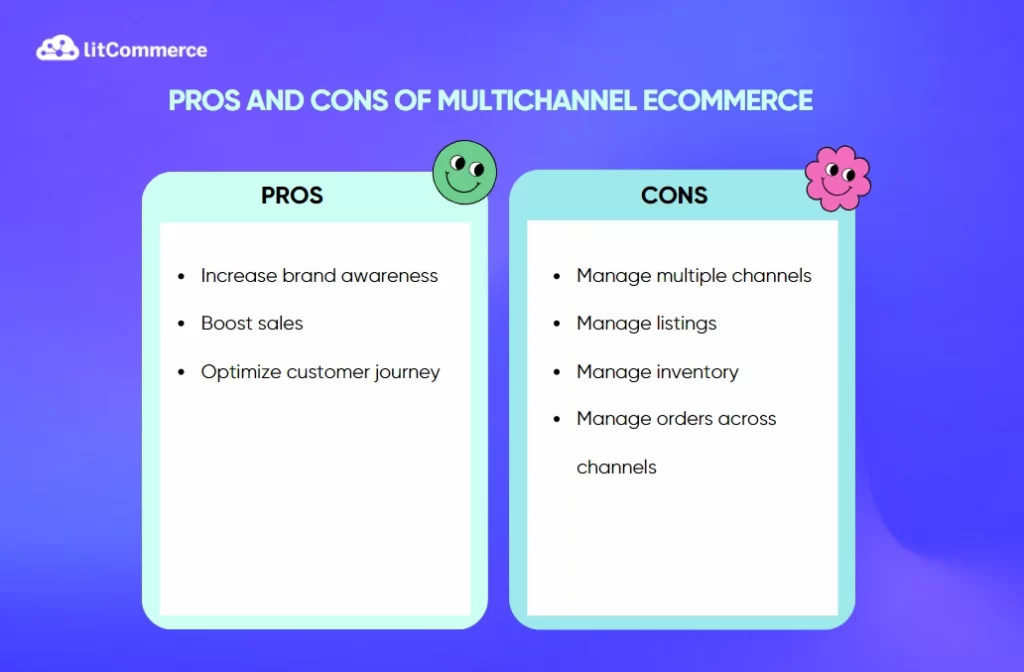
Benefits of multichannel eCommerce
Reaching more channels elevates brand visibility
Through creating an account on the different sites, companies can expand the customer base and present goods or services to the clients who could not otherwise come across the company. Harvard Business Review stated that 73% of consumers engage in the use of multiple channels throughout their purchasing process. Therefore, when a brand posts on various platforms, it creates numerous touchpoints with the target market, hence familiarization with the brand.
A multichannel approach drives higher sales
Perhaps the most prominent benefit of multichannel eCommerce is the possibility of raising sales figures. Every channel a business sells is an additional opportunity to make money. Also, customers have preferences concerning the platforms they use in a particular company. By selling its products in those formats, firms can satisfy such preferences and sell to more consumers. A report indicated that multichannel sellers experience a 190% boost in their overall revenues against single-channel sellers.
Improving the customer journey leads to better satisfaction
Multichannel eCommerce also creates a positive and optimized buyer’s journey for a business. A customer can come across a brand while shopping for products on a platform, scrolling through content, or making a purchase directly through the brand. These flexibility measures improve the general customer experience and help to build trust in the brand.
According to Aberdeen Group, organizations with good customer engagement in an omnichannel setting could enjoy customer loyalty of 89% as opposed to those with poor omnichannel customer engagement, with only 33% customer loyalty.
Challenges of multichannel eCommerce
Juggling multiple channels is overwhelming
The main disadvantage of multichannel eCommerce is the problem-solving of multiple channels, which can make the process rather confusing. Every channel is different because it has rules, algorithms, and what clients expect from your company. Coordinating these factors can be demanding and may require a lot of time and effort, especially for some organizations.
Keeping listings accurate across platforms is challenging
Another significant challenge is ensuring that product listings are accurate, consistent, and optimized across multiple channels. Each platform may have different listing requirements, and maintaining uniformity while optimizing for each channel’s search algorithm can be daunting. Discrepancies in listings can lead to customer confusion, reduced sales, and even platform penalties.
Inventory management becomes a complex task
Managing inventories becomes even more challenging when conducting multiple-sales-channel operations. It is crucial to monitor the stock so as not to run out of stock or oversell the products, which needs proper management systems and timely updates. Out-of-stock situations, low-quality products, overstocked items, and slow-moving goods are some of the negative consequences of ineffective management of stocks.
Tracking orders across different channels is difficult
Processing orders from multiple sources, mainly through multichannel eCommerce sales points, can be quite challenging. There may be minor differences in the order processing, shipping and even the level of customer support expected in each platform. Timely deliveries and high customer satisfaction are hallmarks of optimizing processes and good coordination.
Picking The Right Channels for eCommerce Multichannel
In the eCommerce multichannel context, the channel choice appears to be critical to success. And with so many options available out there, it can be pretty confusing, but worry not because we are here for you
eCommerce marketplaces
eCommerce marketplaces are like bustling virtual malls where multiple sellers can showcase their products to a massive audience. These platforms are essential for reaching millions of potential customers, but each one has its own rules, fees, and audience quirks. Let’s break down some of the top marketplaces in the multichannel eCommerce space.
Amazon
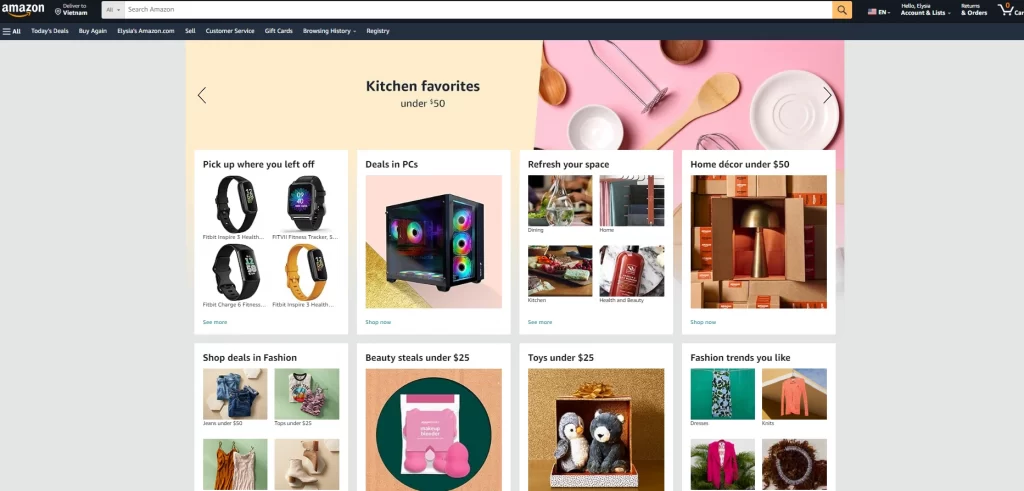
Amazon emerges as the largest and the most popular online shopping platform globally, with over 300 million active users. This platform includes people of all ages and backgrounds. More of these users are Amazon Prime users, considered loyal users of Amazon. They are also willing to pay cash for fast, free shipping and good customer service.
Operating in more than 18 countries—especially strong in the U.S., U.K., Germany, and Japan—Amazon provides sellers access to a global market. What makes Amazon even more appealing is its suite of tools, like Amazon FBA (Fulfillment by Amazon), which handles storage, packaging, and shipping. Plus, Amazon Advertising helps you get your products in front of even more potential buyers.
However, selling on Amazon isn’t without its costs. Sellers must pay a referral fee for each sale, usually 8% to 15%, depending on the product category. On top of that, there are FBA fees and monthly subscription costs for professional sellers.
In a nutshell, Amazon should definitely be part of your multichannel eCommerce strategy if you can offer competitive prices and high-quality products and are ready to invest in marketing and fulfillment to stand out in this crowded marketplace.
eBay
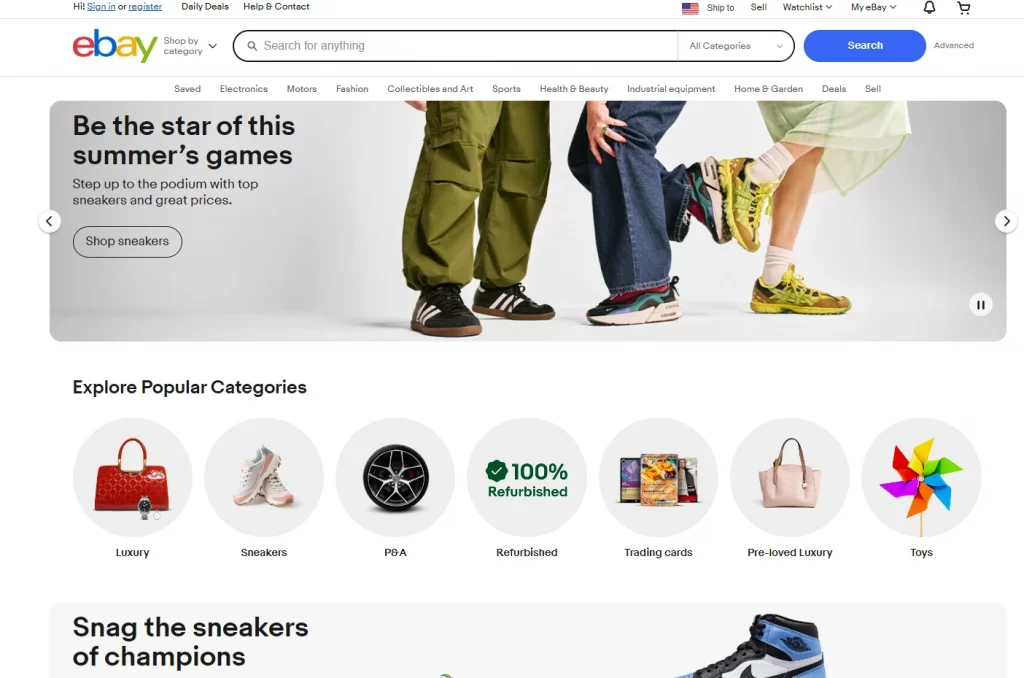
Based in San Jose, California, eBay started as one of the pioneering online selling platforms with more than 182 million active buyers While eBay mainly focuses on an auction-based business model, the company also operates fixed-price listings, which makes eBay appropriate for most kinds of sellers.
A wide array of consumers turn to eBay to engage the excitement of searching for specific items, antiques, or second-hand products. Also, the users are typically price-conscious.
This sales channel operates in more than 190 markets globally, eBay’s most significant markets include the U.S., U.K., Germany, and Australia. Sellers on eBay benefit from tools like eBay Stores, Promoted Listings, and analytics to optimize their sales strategies.
However, like Amazon, eBay charges fees—specifically, a final value fee that’s a percentage of the total sale amount, typically ranging from 10% to 12%. There are also listing fees for certain types of listings.
If you’re selling unique, collectible, or used items, eBay should be a part of your multichannel eCommerce setup, especially if you want to attract buyers looking for niche products and good deals.
Etsy
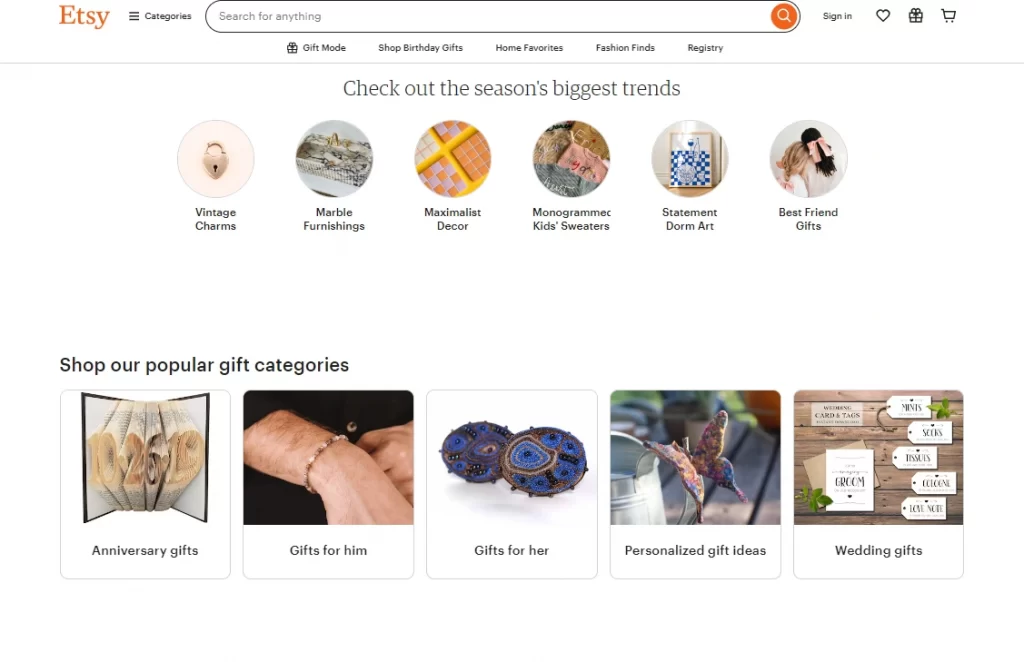
Etsy is a marketplace for handmade, vintage, and one-of-a-kind goods with over 96 million active buyers. It creates a sense of a community-based platform where customers appreciate unique, individually crafted items. Etsy shoppers are often willing to pay a premium for one-of-a-kind items and enjoy supporting independent creators.
Although Etsy focuses on the U.S., U.K., Canada, and Australia, it has started expanding to other areas of the globe. To help the sellers, Etsy has provided features such as Etsy Ads, social media connections, and analytical features to target the customers and gain better sales.
However, selling on Etsy need to pay specific fees for using the site which include a $ $20 per item listing fee, 5% commission on the selling price and 3% plus $0.25 payment processing fee.
For sellers of handmade or unique items, Etsy is an excellent choice for your multichannel eCommerce strategy, especially if you’re looking to reach a community-oriented audience.
Walmart Marketplace

Walmart Marketplace is quickly becoming a go-to platform for third-party sellers, attracting over 120 million monthly visitors. It allows sellers to list products alongside Walmart’s inventory, giving them access to Walmart’s vast customer base. Walmart shoppers seek pragmatic solutions, as they expect the company to offer affordable products, diverse product categories, and speedy delivery services.
While Walmart Marketplace is primarily based in the United States, it is gradually going global with a concentration in North America. Currently, sellers on this platform use services such as Walmart Fulfillment Services (WFS), the same as Amazon FBA, for storage and shipping.
Nonetheless, here are some of the expected fees. Walmart takes a 6-20% referral fee for each sale made through the platform but does not have any monthly membership fees. Thus, it can be considered economical for most sellers.
If you’re an established brand or a seller with competitive pricing and broad product appeal, Walmart Marketplace should be a key part of your multichannel eCommerce strategy.
Other marketplaces (Shopee, Reverb, Onbuy, Wish)
Beyond the big names, there are plenty of other eCommerce marketplaces worth considering for your multichannel eCommerce strategy:
- Shopee: A leading marketplace in Southeast Asia and Taiwan with over 340 million monthly active users, Shopee caters to a young, mobile-savvy, and price-sensitive audience. It offers selling tools like live streaming, in-app games, and social sharing features, but sellers must pay commission and payment processing fees.
- Reverb: Dedicated to musical instruments and gear, Reverb attracts passionate musicians and music enthusiasts. Sellers benefit from listing tools, gear condition guides, and a secure payment system, though they must pay selling and payment processing fees.
- OnBuy: A rapidly growing UK-based marketplace, OnBuy appeals to customers seeking good deals and a reliable shopping experience. Sellers pay a monthly subscription fee and commission fees but benefit from listing tools and marketing support.
- Wish: Known for low prices and a wide variety of products, Wish attracts budget-conscious shoppers, often younger, who don’t mind waiting longer for shipping. Sellers on Wish must pay a revenue share and payment processing fees but can utilize tools like ProductBoost (advertising) and Wish Express (fast shipping program).
To effectively reach customers across various platforms, understanding the nuances of multichannel distribution for businesses is crucial in optimizing your multichannel eCommerce strategy.
What Sales Channels Does LitCommerce Support?
Join LitCommerce Multichannel Selling because we support 20+ selling channels, from the top global online marketplaces to the most popular niche ones, all in one place.
Social media channels
With social commerce sales expected to hit $2.9 trillion globally by 2026, it’s clear that social platforms are becoming key players in the multichannel eCommerce game. The blend of social interaction and shopping convenience is changing how people buy. Moreover, social media acts as an advertising platform for your online business.
Each platform caters to different audiences and buying habits, so adapting your strategy is crucial. Let’s take a closer look at some of the most popular channels.
Google Shopping
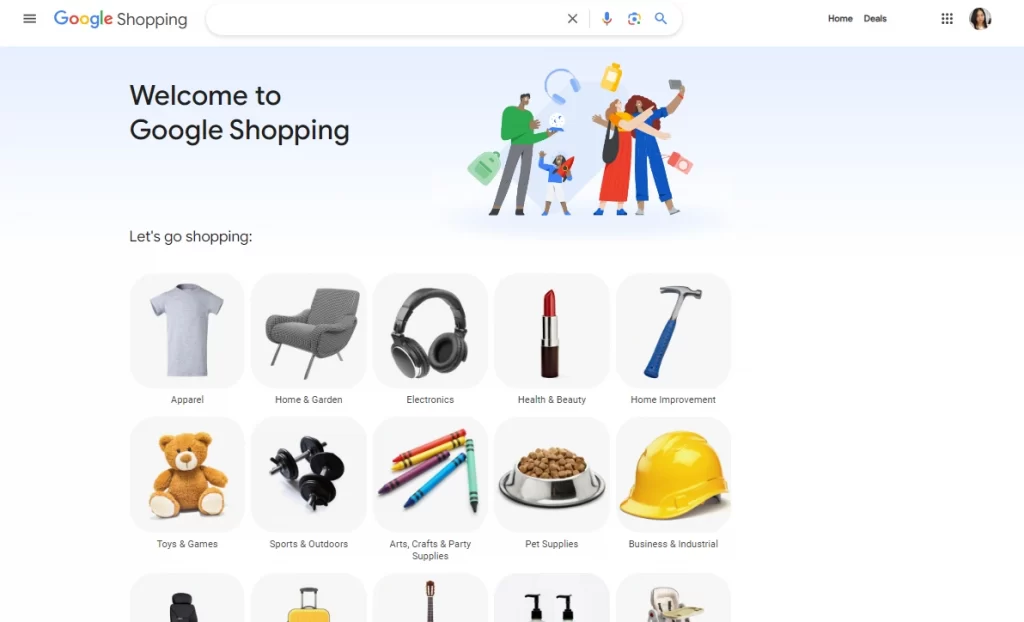
Google Shopping effectively provides traffic and increases sales due to search intent. It enables businesses to display products immediately within the Google search results page that helps in simplification of product differentiation to the consumers. With Google Shopping, you can reach billions of Google users who are actively searching for products, often with a high intent to purchase.
Google offers various tools to optimize your presence on Google Shopping, including Google Ads, product feed management, and performance tracking through Google Analytics. However, it is a pay-per-click platform, meaning you are only required to pay when someone clicks the product ad. The cost is competitive and depends on the bidding strategy and levels of competition.
In short, if your price tags are significantly lower than the competition, and your product listings are well-optimized, Google Shopping must become an inseparable part of your multichannel eCommerce plan.
TikTok Shop
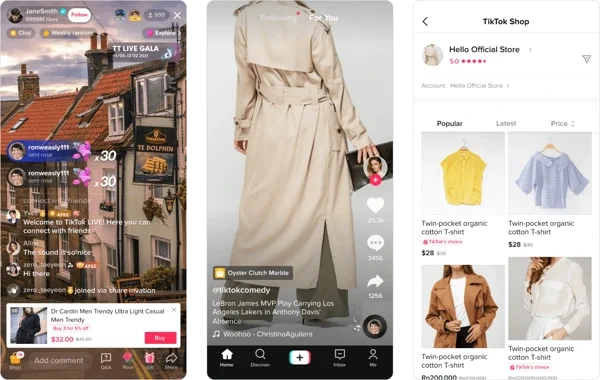
TikTok Shop is an emerging eCommerce platform within the TikTok app, allowing users to discover and purchase products directly through short-form videos. The platform’s rapid growth has become a key channel for brands targeting younger audiences.
When selling on TikTok Shop, you’ll need to pay a commission on each sale, typically around 5%, in addition to payment processing fees.
For trendy, eye-catching products aimed at a younger crowd, including TikTok Shop in your multichannel eCommerce strategy is necessary.
Instagram Shopping
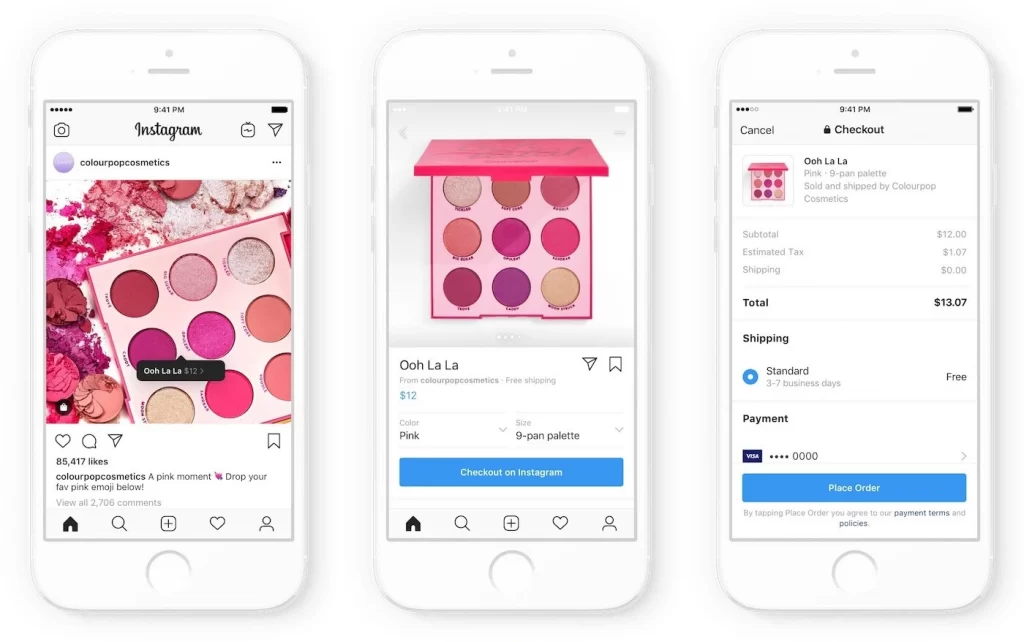
Instagram Shopping is easy to navigate and aligns with the Instagram interface. It enables shopping through posts, stories, and the Explore tab. Instagram Shopping has more than 1 billion monthly active users, making it beneficial for brands that produce visually appealing products.
Instagram shoppers are inspired by visuals and aesthetics, often seeking brands aligning with their lifestyle and values. Instagram provides tools like shoppable posts, product tags, and Instagram Checkout, which allows users to complete purchases without leaving the app.
It’s worth noting that Instagram charges a selling fee of 5% per shipment or a flat fee of $0. 40 with responses reflecting $8 for each shipment
In general, Instagram Shopping is the best multichannel eCommerce for who sell visually appealing products, fashion and beauty brands, and lifestyle brands with strong visual storytelling.
Facebook Shopping
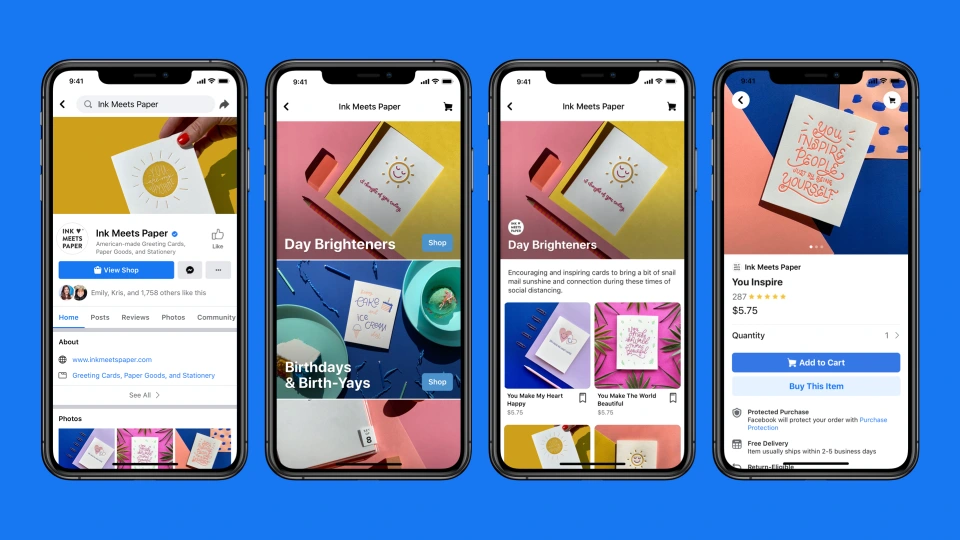
Facebook Shopping allows businesses to create a fully integrated shopping experience directly on Facebook, tapping into its massive user base. It currently has 8 billion active users and penetrates deeper into the greater population, including older and diversified users.
Facebook now has features such as Facebook Shops, where you can create branded spaces to sell products, and Facebook Marketplace, for selling products. Also, regarding targeting, Facebook Ads has incredible pre-setting options with impressive accuracy.
Facebook requires a selling fee commission of 5% of the total shipment or a flat fee of $0.40 for shipments of $8.00 or less, which is the same as Instagram Shopping. There are also costs involved in advertising, which depends on the adverts’ targets and the level of competition.
Integrating Facebook Shopping into your multichannel eCommerce strategy is essential when aiming to reach a wide-ranging audience, especially among older demographics.
Pinterest Shop

Pinterest Shopping has over 450 million active users, with a strong focus on DIY, home decor, fashion, and food. Pinterest’s user base is predominantly female, with a significant portion of users actively planning purchases and seeking inspiration for projects. Shoppers on Pinterest are often in the discovery phase, making it an excellent platform for showcasing visually appealing products that align with lifestyle trends.
Pinterest offers tools like Rich Pins, which provide additional product details directly on the pin, and the Shop the Look feature, which allows users to purchase multiple products from a single pin. Sellers can also use Pinterest Ads to target specific audiences based on interests, keywords, and demographics.
This platform operates on a cost-per-click (CPC) ad model, with costs varying based on targeting and competition. There are no fees for organic product pins.
Finally, we highly recommend Pinterest Shop as a multichannel eCommerce platform for businesses in the fashion, home decor, and DIY niches, with visually appealing products.
Using eCommerce Multichannel Solution Software – LitCommerce
We’ve already highlighted how multichannel eCommerce can boost your online business. But managing it all? That’s where things get tricky. Is there a solution? Absolutely—LitCommerce. This powerful multichannel selling tool is built to streamline the complexities of multichannel selling, with key features like:
- Connecting all your sales channels
- Listing products effortlessly
- Syncing inventory in real-time
- Centralizing your order management.
Let’s explore how these features can make managing your multichannel eCommerce much easier.
Connect multiple sales channels
One of the standout features of LitCommerce is its ability to connect with various sales channels effortlessly. Whether you’re selling on major marketplaces like Amazon, eBay, Etsy, and Walmart or using popular shopping carts such as Shopify, WooCommerce, or BigCommerce, LitCommerce has got you covered. It even integrates with social media platforms like Facebook Shops and TikTok Shop.
This robust connectivity allows you to manage all your product listings, inventory, orders, and customer information from a single, user-friendly dashboard. The advanced technology behind LitCommerce ensures that establishing these connections is straightforward—even if you don’t have a technical background. You can keep your sales channels synchronized and efficient with everything linked up.
List products on multiple channels
Listing products across multiple sales channels can be a daunting task. LitCommerce simplifies this process by providing powerful product listing features:
- Bulk listing: Upload and list products in bulk, saving you significant time and effort.
- Template creation: Create customizable listing templates to maintain consistency across channels.
- Category mapping: Map your product categories to the appropriate categories on each platform.
- Attribute mapping: Match product attributes to the corresponding fields on different channels.
- Pricing rules: Set dynamic pricing rules to adjust prices based on platform-specific requirements or promotions.
Sync inventory across channels
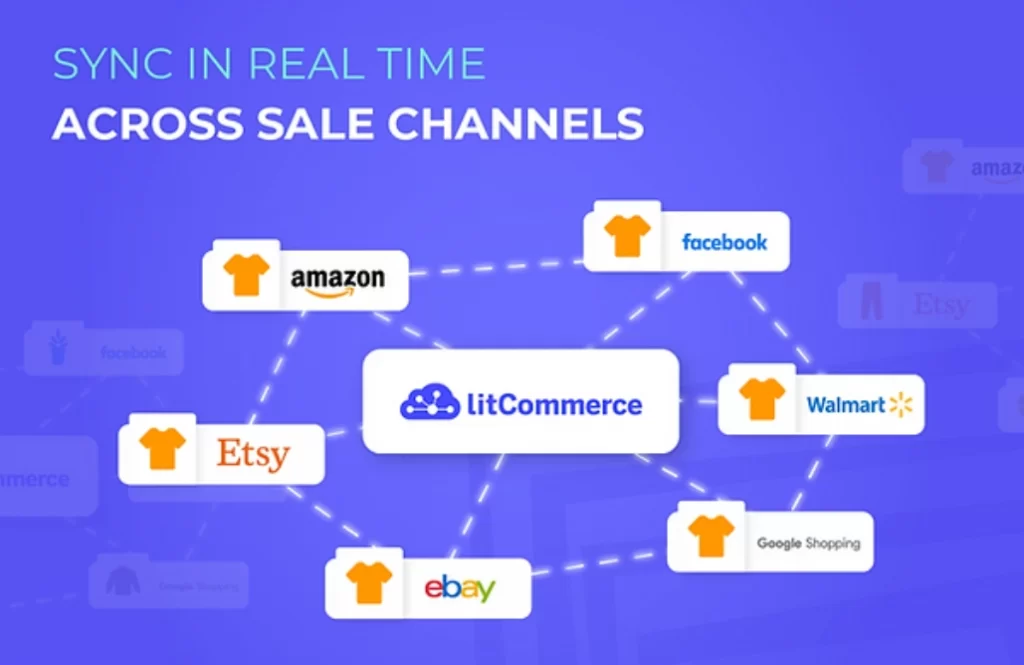
Dealing with inventory across several channels of sales could be quite complex but LitCommerce has made all this easier through the real-time inventory sync feature. Here’s how:
- Real-time synchronization: Keep your product information, including inventory and pricing, consistent across all channels with real-time synchronization. This prevents overselling and ensures accurate product availability information.
- Automated stock adjustments: Any changes in inventory, whether due to returns, exchanges, or restocking, are automatically synced across all channels. This ensures consistency and accuracy.
Centralize order management
Managing orders from various sales channels can be a juggling act, but LitCommerce simplifies this with its centralized order management system:
- Order aggregation: View and handle orders from all your connected channels through a single dashboard.
- Order status updates: Track and update order statuses, keeping customers informed about their shipments and deliveries.
- Order fulfillment: Process orders and generate shipping labels directly from the your eCommerce platform order page.
Why Choose LitCommerce?
LitCommerce is the best and most optimized choice for SMBs, and if you’re hesitant to use a third-party tool, we offer a free plan with no credit card required.
Multichannel vs. Omnichannel eCommerce
The primary distinction between multichannel and omnichannel eCommerce lies in their focus.
Multichannel eCommerce solutions mean selling your products or services across various platforms, such as websites, social media, and physical stores. Each of these channels operates somewhat independently, which can sometimes lead to a fragmented customer experience. While you’re present on multiple channels, each might have its own separate strategy and operations.
On the other hand, omnichannel eCommerce takes things a step further by aiming for a seamless and integrated shopping experience. This approach synchronizes customer interactions and data across all channels. What does this mean in practice? Customers can start a purchase on one channel and effortlessly complete it on another without any hiccups. This strategy delivers a consistent and cohesive experience, ensuring that messaging and branding are unified across every touchpoint.
In a nutshell, multichannel eCommerce is about having a presence on various platforms, whereas omnichannel eCommerce is about crafting a unified experience, regardless of which channel your customers use to interact with your brand.
Multichannel eCommerce – FAQs
Multichannel eCommerce is the process of selling or offering products or services through the use of multiple online channel strategies. This approach enables one to target more clients, create awareness of the business, and exploitation of channels with the most potential in creating sales. Multichannel eCommerce involves selling products across various online platforms like websites, social media, and physical stores, with each channel operating independently. This often results in a fragmented customer experience as there is no synchronization between channels. On the flip side, omnichannel eCommerce major on the use of every channel – digital and physical in a smooth and coherent manner. It provides the capability allowing customers to begin a purchase on one system and complete it on another, without losing the message of the continuity between the two. Amazon primarily flows through multi-channels as it sells through its different channels like its website, its app, and physical stores like Amazon Fresh. However, how these channels have been integrated into the Amazon supply chain by innovative service offers such as Amazon Prime and Amazon FBA, also points to aspects of the omnichannel strategy, which was consequently designed to optimise the overall customer experience.
Optimize Your Multichannel eCommerce Management with LitCommerce
So, now that we’ve explored the ins and outs of multichannel eCommerce, it’s clear that managing multiple sales channels is rewarding and challenging. But don’t worry—LitCommerce has your back. With its powerful tools designed to simplify listing management, inventory updates, and order processing across various platforms, you can focus on what really matters: growing your business.
Are you and your business ready to level up your multichannel eCommerce plan? Allow LitCommerce to be your ally in this endeavor.

